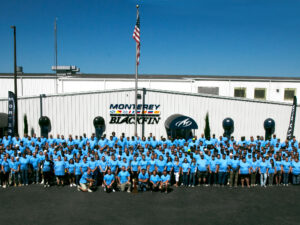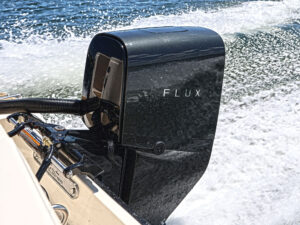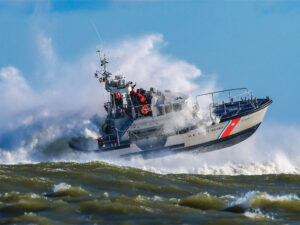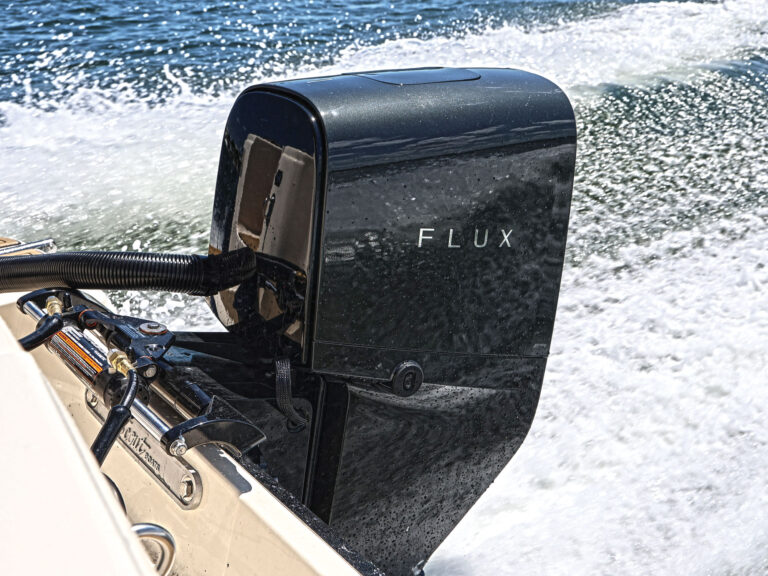Working closely with General Motors Corp., Volvo Penta took the new 6.0-liter fourth-generation V-8 truck engine and created a more fuel-efficient, lighter, quieter marine propulsion system with great durability and maintenance features.
“GM is always exploring ways to reduce noise, harshness and vibration (NHV),” explained Mel Cahoon, manager of Volvo Penta’s engine engineering. “The gen-4 engine gains structural rigidity and low NVH with its deep skirt block with six-bolt main caps.”
Most experts consider a six-bolt main cap securing the crankshaft the strongest design. GM also incorporated a high-flow aluminum cylinder head to reduce weight, Inconel exhaust valves for greater durability and cam-phased variable valve timing (VVT) that creates a flatter torque curve, thus optimizing low-rpm torque and high-rpm horsepower and resulting in faster acceleration and higher top-end engine speed (6,000 rpm) while enhancing long-term durability.
Making the base engine suitable and compliant for use on a modern sterndrive, Volvo adds a high-flow aluminum exhaust system utilizing the latest catalyst technology. With two oxygen sensors, one at the intake of the catalyst and the other post-catalyst, Volvo’s system optimizes the torque and power over a range of fuel grades. In addition, Volvo was able to achieve exceptionally low emissions that are virtually odor-free with a 95 percent reduction of carbon monoxide at idle.
Another plus is that Volvo engineered a completely closed freshwater cooling system to protect the engine and manifolds from corrosive effects of raw water. Closed cooling also makes winterization simpler. A heavy-duty oil cooler heats the oil at low power and cools it at high power, regulating temperature to optimize viscosity and reduce the opportunity for condensation.
To find out if there might be a replacement for displacement, I tested two identical Formula 260 SS sport boats, one powered by the 6-liter V8-380 and the other by a 380 hp 8.2-liter engine. The V8-380 out-accelerated the big block, posting a 28 percent faster time to plane. Fuel consumption was virtually flat from plane to 30 mph on the V8-380-equipped boat and significantly better on all ranges when compared with the boat powered by the 8.2. Note that the V8-380 weighs 926 pounds (1,076 with drive), about 150 pounds, or one crew member, fewer than a big block with comparable horsepower.
I also tested a Formula 380, powered by twin V8-380s, and it was easy to see that the small footprint makes for better serviceability in the typically cluttered engine space of midsize cruisers. The new engine also proved quieter by a large margin, as my decibel meter showed.
What I couldn’t test for was performance while pushing a heavily laden boat in rough water, a scenario in which lots of cubes have historically meant gobs of control.
My conclusion is that Volvo has taken a major stride ahead of the competition by incorporating the latest small-block engine technologies available and producing such a high-performing power package.
Key Features
1. Standard freshwater cooling
2. Variable valve timing
3. Six-bolt main caps
4. Aluminum cylinder heads
5. Inconel exhaust valves
6. Catalyzed aluminum exhaust
Specs: Volvo Penta V8-380
Horsepower: 380
Displacement (liters/cu. in.): 6.0/364
Cylinders: 8
Drive: Duoprop DPS
Available Ratios: 2.14, 1.95








